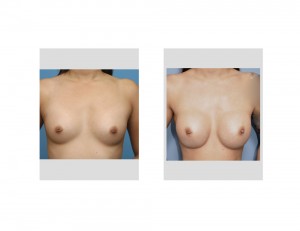Breast augmentation is one of the most commonly performed cosmetic body procedures in the U.S.. While producing immediate and often dramatic changes in breast size and shape, it is a procedure that is associated with a variety of potential complications. Some of these complications are surgery-related (e.g., hematoma) while others are device-related. (e.g., capsular contracture) When all put together, the incidence of complications in breast augmentation surgery is likely underestimated. (at least by many patients)
While not all complications require revisional surgery for resolution, some do. One of these is breast implant malposition. With implants at two different horizontal levels, breast asymmetry results as the position of the nipple-areolar complex is different between the two breasts. Besides the change in breast implant size, the position of the nipple-areolar complex has been shown to be one of the most important factors in satisfaction with breast augmentation surgery. Thus, most plastic surgeons place great emphasis on optimal symmetry of implant position during surgery.

While there are different incisional choices for breast augmentation surgery, the inframammary approach is the most commonly used. It allows for direct visualization of the pocket dissection, casues the least amount of adjacent tissue trauma and allows for direct comparison of the two implant positions. The inframmary approach is also the best to use when placing silcione implants for ease of insertion into the pocket. In my experience, this incisional approach provides the least risk of implant malposition. But implant malposition is not rare and the risk in my practice is in the 5% to 8% range.

The more infrequent type of breast implant malposition is when the implant ends up too low, thus causing a high nipple-areolar complex to occur. This is due to release of the inframammary fold and an ineffective repair of it after implant placement. This is an issue of particular relevance in large implants with thin breast tissues, making them prone to bottoming out from lack of tissue support. With even slight overdissection of the bottom portion of the pocket, this type of breast is prone to this implant malposition problem.
The pocket dissection in placing breast implants is the most critical aspect of the procedure that leads to implant symmetry or asymmetry. Because correcting a low positioned implant is more challenging and unstable than lowering a high one, there is a strong tendency in surgery to be conservative about how low to make the breast implant pocket. This accounts for the more frequent higher breast implant malposition problem.
Dr. Barry Eppley
Indianapolis, Indiana


